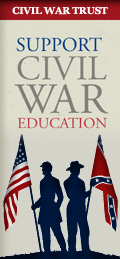Gray faces of war
Longtime collector compiles rare photographs of Confederate soldiers
By Bill Hendrick
For the Atlanta Journal-Constitution
January 25, 2009
One is signed simply but poignantly, "Your son, J.J."
Pvt. James J. McKinley of Company H, 4th Georgia Infantry, sent it home after sitting somewhat anxiously for a newfangled "carte de visit" photograph. That wasn't easy, since photography during the Civil War required subjects to remain motionless for up to 10 seconds. Even the slightest movement would blur the image.
That's one reason not one of the 77 Rebel soldiers in Ronald S. Coddington's brilliant new book, "Faces of the Confederacy," is smiling.
All of the boys and men look rigid, anxious and tired, and it's not hard to imagine loneliness and fear in their countenances.
They had gone off to war, one that claimed more than 289,000 Confederate lives, and all knew quite well that the images for which they were posing could shape the memories held by their loved ones, should they never return.
Happily for his family, McKinley, 17, survived various battles against Gen. William T. Sherman's federal army after it invaded North Georgia, but he still died young of yellow fever 13 years later.
He is not typical of the Confederates pictured in the book, however. Most images are of junior officers — lieutenants, captains, majors or boys and men from fairly prominent families.
After the first two years of the 1861-65 conflict, the Union's blockade made processing supplies rare and images too expensive for most ordinary Confederates.
But you won't find Robert E. Lee's picture in this prodigiously researched volume, only the ordinary sort who died far from home or survived to become farmers or clerks or wanderers.
Coddington found a few of the images in dusty archives, but most came from prominent collectors such as David Wynn Vaughan of Atlanta.
The book is a companion to Coddington's 2004 work, "Faces of the Civil War: An Album of Union Soldiers and Their Stories." But those pictures were much easier to find, in part because the South was in a state of economic depression and social breakdown for decades after Lee's surrender, and people struggling to survive were less likely than their northern counterparts to spend money or take any pains at all to save pictures — or even remember much about rebellious ancestors.
That's why this latest work is so impressive. Not only did he find the few prominent collectors of extremely rare Civil War photographs, but — as the endnotes of the book make obvious — spent years digging through rare manuscripts, magazines and dust-mite-filled letters and diaries.
Coddington, a 45-year-old University of Georgia graduate, tells detailed, haunting stories of the individual soldiers that even their grandchildren likely wouldn't have been able to relate.
A passionate artist and longtime collector himself of Civil War-era photographs, Coddington puts a human face, often a sad one, on a devastatingly bloody struggle that still has an impact on American culture.
"The history of the Civil War is the stories of its soldiers," Coddington writes in the preface.
What follows is masterful. The pictures, in reality only 4-by-2 1/2 inches, are presented full page. Small details in the pictures and narratives enlighten the quirkiness and weird formality of the Victorian era at all levels of society.
McKinley, for example, signed his small photo, "Your son, J.J.," but added the letters "McK," as if his parents wouldn't know. He apparently never left Georgia, though his unit did.
William Proby Young, surgeon in the same regiment as McKinley, served "heroically" in the Battle of Antietam, according to an official report. He settled in Washington after the war, married and had four girls. In addition to practicing medicine, he worked as a real estate broker and secretary of a fire insurance company before dying at age 78 in 1912.
2nd Lt. John Lewis Ells Jr., born in Bibb County and wounded at Antietam, named his third child, a daughter, Jefferson Davis "Jeffie" Ells. The family moved to Baltimore, where Ells worked as a newspaperman and died in 1889 at 60.
Pvt. James D. Means, a gaunt, skinny member of the 5th Georgia Reserve Infantry, died of disease just shy of his 19th birthday in Macon. An obituary that Coddington dug up said the youth was "obedient and very affectionate to his parents."
Lt. Col. William Gaston Delony, a University of Georgia honors graduate and one of the highest-ranking soldiers in the book, was described in the diary of one of his men as "a game fighter" who "dared to attempt anything, even though it seemed impossible to others." But he had "a weakness for alcohol." Buried near Gettysburg after that battle, his remains later were disinterred and reburied in Athens.
Coddington, who met his wife, Anne, while majoring in art in Athens, started collecting photographs at 14, and as an aspiring artist, "drew portraits of all the major historical figures in my textbooks." He bought pictures at flea markets, Civil War shows, then later on eBay.
Coddington's prose is as unpretentious as the faces he shares, yet authoritative. It resurrects details that broaden our understanding of those sad times and sheds valuable light on the shape of modern culture.
|
